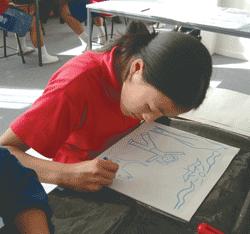 |
Attitudes
and Motivation
Students’ attitudes, interests and liking for a subject
have a strong bearing on their achievement. The Art Survey sought
information from students about their curriculum preferences and
their perceptions of their own achievement. The questions were
the same for year 4 and year 8 students. The survey was administered
to the students in an independent session (four students working
individually on tasks supported by a teacher). The questions were
read to year 4 students, and also to individual year 8 students
who requested this help. Writing help was available if requested.
Visual
Arts Surveys
The survey included one item which asked them to select three preferences
from a list, 13 items which asked students to record a rating response
by circling their choice, one item which asked them to tick boxes to
indicate frequency of activities, and one which asked them to list preferred
activities.
|
Students first were asked to select their three favourite school subjects
from a list of 14 subjects. Among the year 4 students, physical education
was the most popular subject, listed as first, second or third choice
by 51 percent of year 4 students. Visual art came second (41%), maths
third (34%), art fourth (32%) and reading fifth (27%). Music rated seventh
(23%), dance eighth (18%) and drama ninth (16%). With drama and dance
added to the subject list used in 1999, the percentages in 2003 and
1999 are not directly comparable, but it is noteworthy that while physical
education attracted about 50 percent support in both years, and art
and maths were in the 30s both times, visual art has dropped in “top
three” support from 80 percent of students to 41 percent of students.
This largely may be accounted for by addition of two other art forms
to the subject list, and by the term “art” being used in
the subject list in 1999 but “visual art” in 2003. The sum
of the percentages for all four art forms is nine lower than the sum
for art and music in 1999, suggesting that the large decrease for visual
art was not caused entirely by the addition of dance and drama.
In the corresponding results for year 8 students, physical education
was first in popularity (61%), technology second (44%), visual art third
(32%), drama fourth (25%), maths fifth (24%) and art sixth (21 %). Dance
rated seventh (16%) and music eighth equal (15%). The percentages choosing
physical education, technology, mathematics and art have stayed almost
the same as in 1999, but the percentage choosing “visual art”
in 2003 is 24 lower than the percentage choosing “art” in
1999. On the other hand, the sum of the percentages for all four art
forms in 2003 is nine higher than the sum for art and music in 1999.
The drop for visual art has been more than equalled by the gain from
adding drama and dance.
Students were asked
an open question: What do you like doing most in art in your own time?
Drawing was easily the most highly rated activity by both year 4 and
year 8 students (59 and 69 percent of students, respectively), followed
by painting (about 30 percent for both years).
Responses to the 13 rating items are presented in separate tables for
year 4 and year 8 students, together with students’ perceptions
of the relative frequency of 10 different art making activities in school.
The corresponding results from 1999 are shown alongside.
|
| The year 4 results
suggest that art remains a popular activity, both in school and out,
with about three quarters of the students choosing the highest rating
for their enjoyment of art at school and wanting more art at school.
About half were similarly positive about art activities in their own
time and about continuing to learn art when they grew up. The most notable
changes from the 1999 results were moderate increases in the percentages
of students who said they didn’t know how good they were at art
or how their teacher or parent viewed their ability at art, and a larger
decline in the percentage of students who believed their parents were
very positive about their ability in art.
|
At year 8 level,
the 2003 results are similar to those for 1999. There appear to be small
declines in the popularity of art at school and in the desire for additional
art at school, but about 50 percent still give high ratings on both issues
(higher than for most subjects in other NEMP surveys at year 8 level).
Computer graphics was included in the survey for the first time this year:
29 percent of students reported using this technique in art at school
“heaps” or “quite a lot” (more than printmaking,
collage, carving, model making, clay and fabrics, with which experience
was quite limited). Only 25 percent of year 8 students reported looking
at or talking about art at school more than “sometimes”, 5
percent fewer than in 1999.
|
